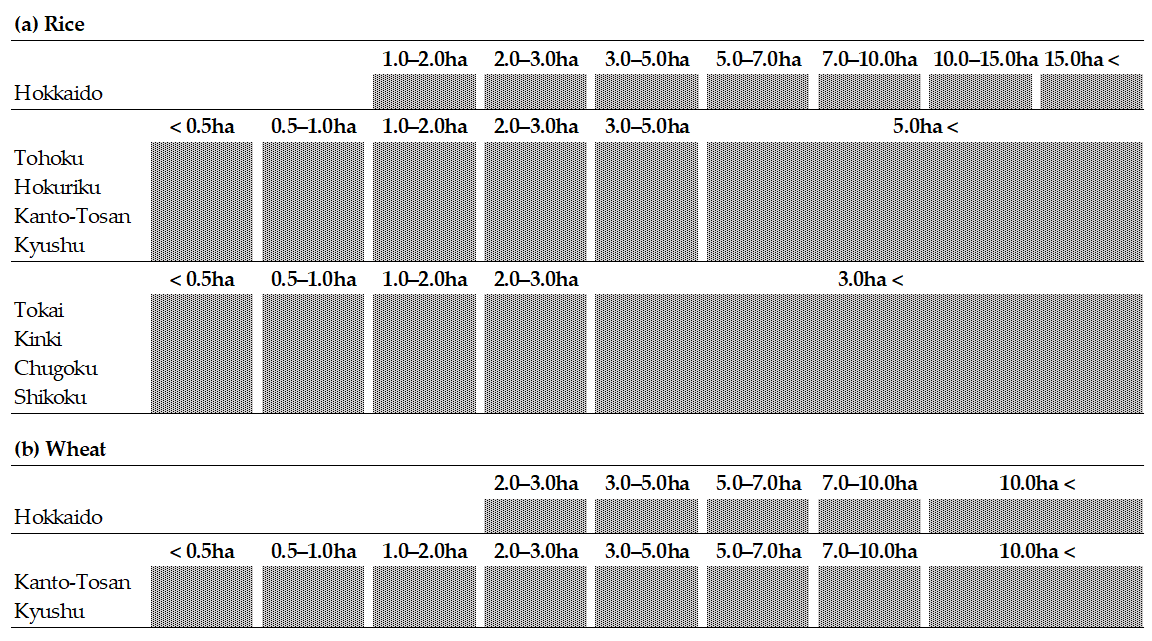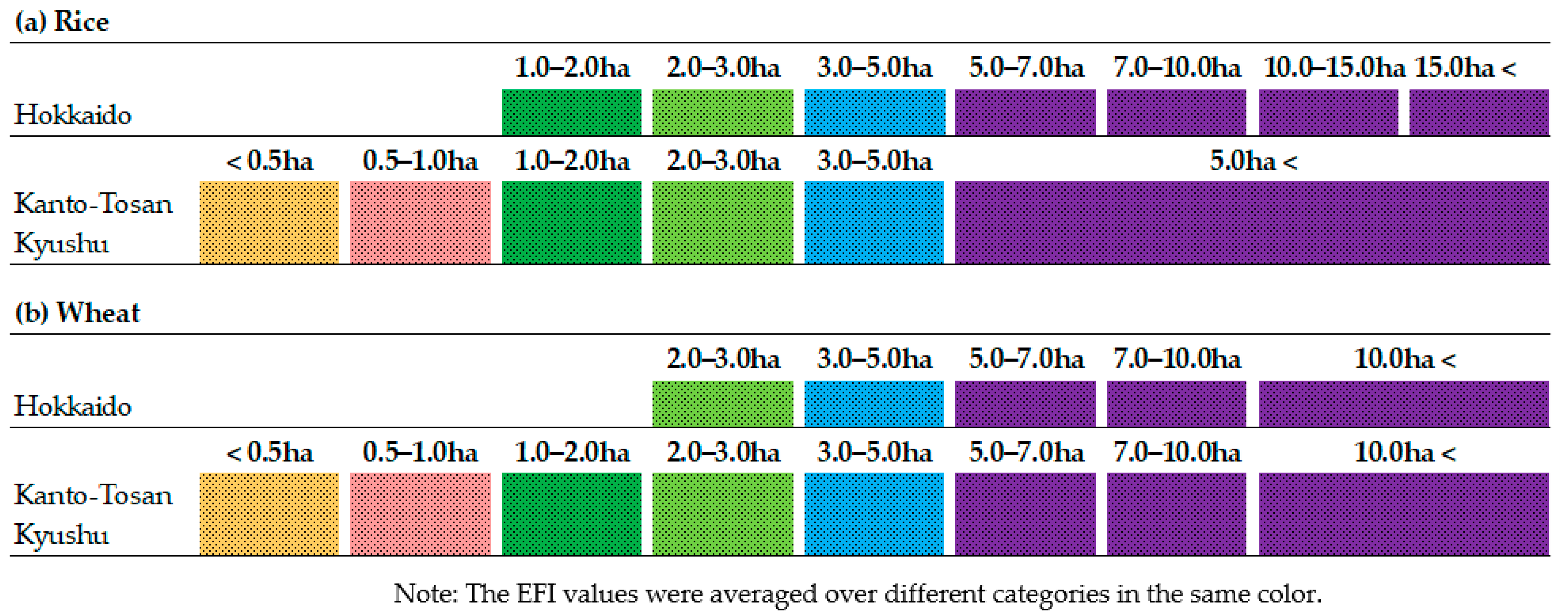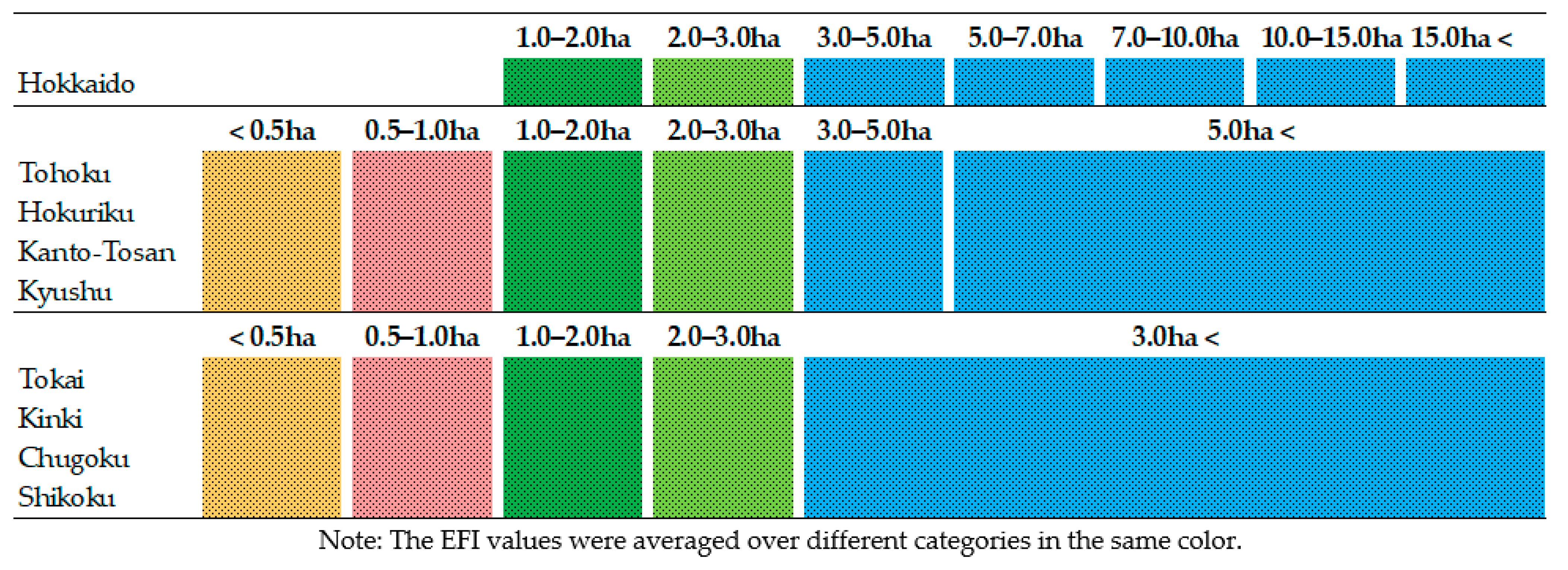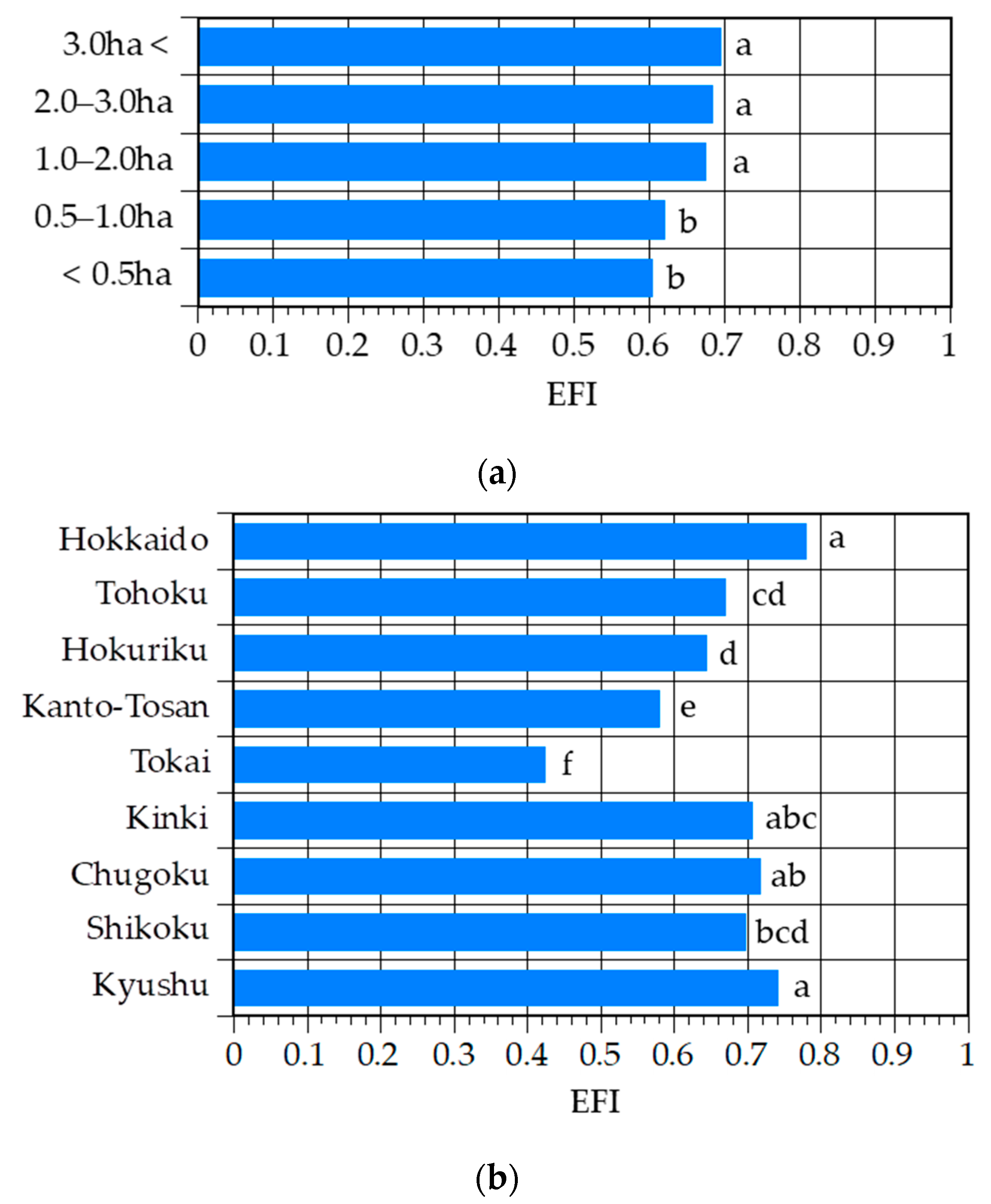Exploring Farmers’ Expectation toward Farm-Gate Price of Rice in Japan by Positive Mathematical Programming
Abstract
1. Introduction
2. Materials and Methods
2.1. Model
2.2. Calibration Procedure
2.3. Selecting Calibration Methods
2.4. Dataset
2.5. Calculation of EFI and Statistical Analysis
3. Results
3.1. Selected Calibration Methods and Model Evaluation
3.2. EFI and ANOVA Results
4. Discussion
5. Conclusions
Author Contributions
Funding
Institutional Review Board Statement
Informed Consent Statement
Data Availability Statement
Conflicts of Interest
Appendix A. Mathematical Background Proving
Appendix B. Detailed Explanations as to the Dataset Used in the Present Study
| (a) Rice | |||||||||
| 1.0–2.0 ha | 2.0–3.0 ha | 3.0–5.0 ha | 5.0–7.0 ha | 7.0–10.0 ha | 10.0–15.0 ha | 15.0 ha< | |||
| Hokkaido | 9.8 | 8.7 | 9.7 | 8.4 | 8.1 | 7.9 | 9.7 | ||
| <0.5 ha | 0.5–1.0 ha | 1.0–2.0 ha | 2.0–3.0 ha | 3.0–5.0 ha | 5.0 ha< | ||||
| Tohoku | 5.6 | 6.4 | 7.5 | 8.1 | 8.4 | 8.8 | |||
| Hokuriku | 6.1 | 7.3 | 7.6 | 8.5 | 7.0 | 7.7 | |||
| Kanto-Tosan | 2.5 | 3.8 | 4.5 | 5.6 | 6.5 | 7.0 | |||
| Kyushu | 5.6 | 6.8 | 8.6 | 8.7 | 7.8 | 10.3 | |||
| <0.5 ha | 0.5–1.0 ha | 1.0–2.0 ha | 2.0–3.0 ha | 3.0 ha< | |||||
| Tokai | 2.4 | 7.1 | 6.0 | 3.3 | 6.0 | ||||
| Kinki | 2.1 | 3.5 | 6.1 | 5.8 | 6.2 | ||||
| Chugoku | 4.6 | 5.9 | 6.9 | 8.8 | 9.5 | ||||
| Shikoku | 8.6 | 5.5 | 9.6 | 8.9 | 4.7 | ||||
| (b) Wheat | |||||||||
| <0.5 ha | 0.5–1.0 ha | 1.0–2.0 ha | 2.0–3.0 ha | 3.0–5.0 ha | 5.0–7.0 ha | 7.0–10.0 ha | 10.0 ha< | ||
| Hokkaido | 78.9 | 76.5 | 75.2 | 73.3 | 71.9 | ||||
| Kanto-Tosan | 62.0 | 84.2 | 82.2 | 86.0 | 84.8 | 84.5 | 83.7 | 86.5 | |
| Kyushu | 46.3 | 81.8 | 82.0 | 78.3 | 81.9 | 83.1 | 84.4 | 85.5 | |



References
- FAOSTAT. Available online: https://www.fao.org/faostat/en/ (accessed on 5 September 2022).
- Ito, S.; Peterson, E.W.F.; Grant, W.R. Rice in Asia: Is it becoming an inferior good? Am. J. Agric. Econ. 1989, 71, 32–42. [Google Scholar] [CrossRef]
- Huang, J.; David, C.C. Demand for cereal grains in Asia: The effect of urbanization. Agric. Econ. 1993, 8, 107–124. [Google Scholar] [CrossRef]
- Pingali, P. Westernization of Asian diets and the transformation of food systems: Implications for research and policy. Food Policy 2007, 32, 281–298. [Google Scholar] [CrossRef]
- Otsuka, K.; Hayami, Y. Goals and consequences of rice policy in Japan, 1965–1980. Am. J. Agric. Econ. 1985, 67, 529–538. [Google Scholar] [CrossRef]
- Hayami, Y. Japanese Agriculture under Siege; Macmillan: Hampshire, UK, 1988. [Google Scholar]
- Fukuda, H.; Dyck, J.H.; Stout, J. Rice Sector Policies in Japan. US Department of Agriculture, Economic Research Service. 2003. Available online: https://www.ers.usda.gov/webdocs/outlooks/38485/38019_rcs0303-01.pdf?v=5614.8 (accessed on 5 September 2022).
- Wailes, E.J.; Ito, S.; Cramer, G.L. Japan’s Rice Market: Policies and Prospects for Liberalization; Research Reports 257670; University of Arkansas, Arkansas Agricultural Experiment Station: Fayetteville, AR, USA, 1997. [Google Scholar] [CrossRef]
- Honma, M.; Hayami, Y. Structure of agricultural protection in industrial countries. J. Int. Econ. 1986, 20, 115–129. [Google Scholar] [CrossRef]
- Thies, C.G.; Porche, S. The political economy of agricultural protection. J. Polit. 2007, 69, 116–127. [Google Scholar] [CrossRef]
- OECD. OECD Factbook 2013: Economic, Environmental and Social Statistics; OECD Publishing: Paris, France, 2013. [Google Scholar] [CrossRef]
- Anderson, K.; Hayami, Y.; George, A.; Honma, M.; Otsuka, K.; Saxon, E.; Shei, S.; Tyres, R. The Political Economy of Agricultural Protection: East Asia in International Perspective; Allen & Unwin in Association with the Australia-Japan Research Centre, Australian National University: Sydney, Australia, 1986. [Google Scholar]
- Huang, S.W. Structural change in Taiwan’s agricultural economy. Econ. Dev. Cult. Chang. 1993, 42, 43–65. [Google Scholar] [CrossRef]
- Tobias, A.; Molina, I.; Valera, H.G.; Mottaleb, K.A.; Mohanty, S. Handbook on Rice Policy for Asia; International Rice Research Institute: Los Baños, Philippines, 2012. [Google Scholar] [CrossRef]
- Heckelei, T.; Britz, W. Models based on positive mathematical programming: State of the art and further extensions. In Modelling Agricultural Policies: State of the Art and New Challenges, Proceedings of the 89th EAAE Seminar, Parma, Italy, 2–5 February 2005; Arfini, F., Ed.; European Association of Agricultural Economists: Wageningen, The Netherlands, 2005; pp. 48–73. [Google Scholar] [CrossRef]
- de Frahan, B.H.; Buysse, J.; Polomé, P.; Fernagut, B.; Harmignie, O.; Lauwers, L.; Huylenbroeck, G.V.; Meensel, J.V. Positive mathematical programming for agricultural and environmental policy analysis: Review and practice. In Handbook of Operations Research in Natural Resources; Weintraub, A., Romero, C., Bjørndal, T., Epstein, R., Miranda, J., Eds.; Springer: New York, NY, USA, 2007; pp. 129–154. [Google Scholar] [CrossRef]
- Nakashima, T. Positive mathematical programming for farm planning. Jpn. Agric. Res. Q. 2011, 45, 251–258. [Google Scholar] [CrossRef][Green Version]
- Heckelei, T.; Britz, W.; Zhang, Y. Positive mathematical programming approaches–recent developments in literature and applied modelling. Bio-Based Appl. Econ. 2012, 1, 109–124. [Google Scholar] [CrossRef]
- Mérel, P.; Howitt, R. Theory and application of positive mathematical programming in agriculture and the environment. Annu. Rev. Resour. Econ. 2014, 6, 451–470. [Google Scholar] [CrossRef]
- Buysse, J.; Fernagut, B.; Harmignie, O.; de Frahan, B.H.; Lauwers, L.; Polomé, P.; Van Huylenbroeck, G.; Van Meensel, J. Farm-based modelling of the EU sugar reform: Impact on Belgian sugar beet suppliers. Eur. Rev. Agric. Econ. 2007, 34, 21–52. [Google Scholar] [CrossRef]
- Gocht, A.; Ciaian, P.; Bielza, M.; Terres, J.-M.; Röder, N.; Himics, M.; Salputra, G. EU-wide economic and environmental impacts of CAP greening with high spatial and farm-type detail. J. Agric. Econ. 2017, 68, 651–681. [Google Scholar] [CrossRef]
- MAFF. Production Costs for Rice and Wheat. Available online: https://www.maff.go.jp/j/tokei/kouhyou/noukei/seisanhi_nousan/index.html (accessed on 5 September 2022).
- Kusakari, H. A quantitative analysis of the effects of an acreage allotment program between different farm size classes in Japanese rice production. J. Rural Econ. 1989, 61, 10–18, (In Japanese with English Summary). [Google Scholar] [CrossRef]
- Godo, Y. Policy mix of price support and acreage allotment programs in Japanese rice sector. Econ. Rev. 1993, 44, 32–40, (In Japanese with English Title). [Google Scholar] [CrossRef]
- Howitt, R.E. Positive mathematical programming. Am. J. Agric. Econ. 1995, 77, 329–342. [Google Scholar] [CrossRef]
- Paris, Q.; Howitt, R.E. An analysis of ill-posed production problems using maximum entropy. Am. J. Agric. Econ. 1998, 80, 124–138. [Google Scholar] [CrossRef]
- Nakashima, T.; Ishikawa, S. Linking life cycle assessment to bioeconomic modelling with positive mathematical programming: An alternative approach to calibration. J. Clean. Prod. 2017, 167, 875–884. [Google Scholar] [CrossRef]
- Kanellopoulos, A.; Berentsen, P.; Heckelei, T.; Van Ittersum, M.; Lansink, A.O. Assessing the forecasting performance of a generic bio-economic farm model calibrated with two different PMP variants. J. Agric. Econ. 2010, 61, 274–294. [Google Scholar] [CrossRef]
- Hazell, P.B.R.; Norton, R.D. Mathematical Programming for Economic Analysis in Agriculture; Macmillan: New York, NY, USA, 1986. [Google Scholar]
- Askari, H.; Cummings, J.T. Estimating agricultural supply response with the Nerlove model: A survey. Int. Econ. Rev. 1977, 18, 257–292. [Google Scholar] [CrossRef]
- Nerlove, M.; Bessler, D.A. Expectations, information and dynamics. In Handbook of Agricultural Economics 1A; Gardner, B., Rausser, G.C., Eds.; Elsevier: Amsterdam, The Netherlands, 2001; pp. 155–206. [Google Scholar] [CrossRef]
- Tanaka, Y.; Sato, Y. An institutional case study of Japanese Water Users Association: Towards successful participatory irrigation management. Paddy Water Environ. 2003, 1, 85–90. [Google Scholar] [CrossRef]
- Takayama, T.; Matsuda, H.; Nakatani, T. The determinants of collective action in irrigation management systems: Evidence from rural communities in Japan. Agric. Water Manag. 2018, 206, 113–123. [Google Scholar] [CrossRef]
- Kondo, T. Econometric analysis of mechanical technology and the feasibility of leasing large-scale paddy farms. J. Rural. Econ. 1991, 63, 79–90, (In Japanese with English Summary). [Google Scholar] [CrossRef]
- Ito, J. Some proposals for reforming the production adjustment program in Japanese rice sector. J. Rural. Econ. 1993, 65, 137–147, (In Japanese with English Summary). [Google Scholar] [CrossRef]
- MAFF. Census of Agriculture and Forestry. Available online: https://www.maff.go.jp/j/tokei/census/afc/past/stats.html (accessed on 5 September 2022).
- Redondo-Sama, G.; Matulic, V.; Munté-Pascual, A.; de Vicente, I. Social work during the COVID-19 crisis: Responding to urgent social needs. Sustainability 2020, 12, 8595. [Google Scholar] [CrossRef]
- Tanaka, T.; Okamoto, S. Increase in suicide following an initial decline during the COVID-19 pandemic in Japan. Nat. Hum. Behav. 2021, 5, 229–238. [Google Scholar] [CrossRef]
- Laborde, D.; Martin, W.; Swinnen, J.; Vos, R. COVID-19 risks to global food security. Science 2020, 369, 500–502. [Google Scholar] [CrossRef]
- Xu, Z.; Elomri, A.; Kerbache, L.; El Omri, A. Impacts of COVID-19 on global supply chains: Facts and perspectives. IEEE Eng. Manag. Rev. 2020, 48, 153–166. [Google Scholar] [CrossRef]
- Salih, A.A.; Baraibar, M.; Mwangi, K.K.; Artan, G. Climate change and locust outbreak in East Africa. Nat. Clim. Chang. 2020, 10, 584–585. [Google Scholar] [CrossRef]
- Xu, Z.; Elomri, A.; El Omri, A.; Kerbache, L.; Liu, H. The compounded effects of COVID-19 pandemic and desert locust outbreak on food security and food supply chain. Sustainability 2021, 13, 1063. [Google Scholar] [CrossRef]
- Ishikawa, S.; Nakashima, T.; Iizumi, T.; Hare, M.C. Evaluating irrigated rice yields in Japan within the climate zonation scheme of the global yield gap atlas. J. Agric. Sci. 2020, 158, 718–729. [Google Scholar] [CrossRef]





| Variables | |
| Land area allocated to a given crop in the farm-scale category denoted as | |
| Farmers’ expectation toward the farm-gate price including the subsidy of the crop | |
| Parameters | |
| Constant term of the farm-gate price expectation formula to be calibrated | |
| Linear coefficient of the farm-gate price expectation formula to be calibrated | |
| Yield of the crop per unit area | |
| Sum of the variable cost for purchasable inputs per unit area | |
| Number of farms considered in each farm scale category | |
| Land area constraint | |
| Labor hour per unit area | |
| Labor hour constraint | |
| Rice | Wheat | |||||
|---|---|---|---|---|---|---|
| PADmean | ME | PADmean | ME | |||
| Hokkaido | 5.4 | G | 4.1 | E | ||
| Tohoku | 8.3 | G | ||||
| Hokuriku | 8.1 | G | ||||
| Kanto-Tosan | 11.5 | 6.1 | G | |||
| Tokai | 14.8 | |||||
| Kinki | 5.8 | G | ||||
| Chugoku | 4.1 | E | ||||
| Shikoku | 8.0 | G | ||||
| Kyushu | 5.7 | G | 5.1 | G | ||
| Hypothesis 1 | Hypothesis 2 | |
|---|---|---|
| Crop | ns | – |
| Region | *** | *** |
| Farm scale | – | *** |
| Crop × Region | *** | – |
| Farm scale × Region | – | ns |
| Year | *** | *** |
| D.F. | 219 | 251 |
Disclaimer/Publisher’s Note: The statements, opinions and data contained in all publications are solely those of the individual author(s) and contributor(s) and not of MDPI and/or the editor(s). MDPI and/or the editor(s) disclaim responsibility for any injury to people or property resulting from any ideas, methods, instructions or products referred to in the content. |
© 2022 by the authors. Licensee MDPI, Basel, Switzerland. This article is an open access article distributed under the terms and conditions of the Creative Commons Attribution (CC BY) license (https://creativecommons.org/licenses/by/4.0/).
Share and Cite
Nakashima, T.; Ishikawa, S. Exploring Farmers’ Expectation toward Farm-Gate Price of Rice in Japan by Positive Mathematical Programming. Sustainability 2023, 15, 621. https://doi.org/10.3390/su15010621
Nakashima T, Ishikawa S. Exploring Farmers’ Expectation toward Farm-Gate Price of Rice in Japan by Positive Mathematical Programming. Sustainability. 2023; 15(1):621. https://doi.org/10.3390/su15010621
Chicago/Turabian StyleNakashima, Takahiro, and Shoko Ishikawa. 2023. "Exploring Farmers’ Expectation toward Farm-Gate Price of Rice in Japan by Positive Mathematical Programming" Sustainability 15, no. 1: 621. https://doi.org/10.3390/su15010621
APA StyleNakashima, T., & Ishikawa, S. (2023). Exploring Farmers’ Expectation toward Farm-Gate Price of Rice in Japan by Positive Mathematical Programming. Sustainability, 15(1), 621. https://doi.org/10.3390/su15010621






